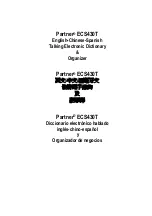
Tone Generator Block
MOTIF-RACK XS Owner’s Manual
50
Basic Structure
Ref
erence
V
oice
Multi
Utility
The Contr
ols &
Connector
s
Setting Up
Listening to
the Sound
Connections
Using a Computer
Quic
k Guide
Appendix
The tone generator block is what actually produces sound in response to the MIDI messages received from the Controller block, the
Arpeggio block and from the external MIDI instrument via the MIDI IN terminal, the USB terminal, or the mLAN terminal. The MIDI
messages are assigned to sixteen independent channels, and this instrument is capable of handling sixteen MIDI channels. The
sixteen-channel limit can be overcome by using separate MIDI “ports,” each supporting sixteen channels. The tone generator block
responds to those MIDI messages assigned to Port 1.
The structure of the tone generator block differs depending on the mode.
Tone Generator block in the
Voice mode
In this mode, the tone generator block receives MIDI data over a
single channel. This status is referred to as a “single timbre”
tone generator.
The MIDI receive channel in the Voice mode can be determined
by setting the Receive Ch (Basic Receive Channel) parameter
(page 102) in the Voice MIDI window of the Utility mode.
n
Keep in mind that song data on an external sequencer consisting of
multiple MIDI channels will not play back properly in this mode. If you are
using an external MIDI sequencer or computer to play the instrument,
make sure to use the Multi mode.
A program that contains the sonic elements for generating a
specific musical instrument sound is referred to as a “Voice.”
Internally, there are two Voice Types: Normal Voices and Drum
Voices. Normal Voices are mainly pitched musical instrument
type sounds that can be played over the range of a keyboard.
Drum Voices are mainly percussion/drum sounds that are
assigned to individual notes on the keyboard.
Each Voice consists of up to eight elements (Normal Voice) or
up to 73 keys (Drum Voice). The elements and keys are the
smallest unit that make up a Voice, and to each can be assigned
a different instrument sound. Voice data consists of the Element
Edit parameters (for each element)/Key Edit parameters (for
each key) and Common Edit parameters (applied commonly to
all the elements/keys). The Common Edit parameters can be
edited on the MOTIF-RACK XS while the Element Edit/Key Edit
parameters can be edited only on the MOTIF-RACK XS Editor
installed to your computer.
n
For instructions on editing a Normal Voice, see page 64. For instructions on
editing a Drum Voice, see page 83.
Normal Voices
These are Voices which are played conventionally from the
keyboard, with standard pitches sounding for each key. A
Normal Voice consists of up to eight Elements. Depending on
the settings in the Voice Edit mode, these Elements are sounded
simultaneously, or the different Elements are sounded according
to the note range, velocity range and the XA (Expanded
Articulation) settings.
The illustration below is an example of a Normal Voice. Since the
six Elements here are distributed across both the note range of
the keyboard and the velocity range, a different Element sounds
depending on which note you play and how strongly you play it.
In the note distribution, Elements 1 and 2 sound in the lower
range of the keyboard, Elements 3 and 4 sound in the middle
range, and Elements 5 and 6 sound in the higher range. In the
velocity distribution, Elements 1, 3 and 5 sound when playing
the keyboard softly, while Elements 2, 4 and 6 sound when
playing it strongly. In a practical example of this in use, a piano
Voice could be composed of six different samples. Elements 1,
3 and 5 would be the sounds of the piano played softly, over the
respective note ranges, while Elements 2, 4 and 6 would be
strongly played sounds, for each respective note range.
Actually, the MOTIF-RACK XS is even more flexible than this,
since it allows up to eight independent Elements.
Drum Voices
Drum Voices are mainly percussion/drum sounds that are
assigned to individual notes on the keyboard. A collection of
assigned percussion/drum waves or Normal Voices is known as
a Drum Kit.
Tone Generator Block
Part structure in the Voice mode
Voice
Normal Voices and Drum Voices
Velocity
Element 1
Element 2
Element 3
Element 4
Element 5
Element 6
Key 1
Key 5 Key 10 Key 18 Key 21
Key 73
C0
C1
C6
Individual
drum sounds
(different for
each key)
















































